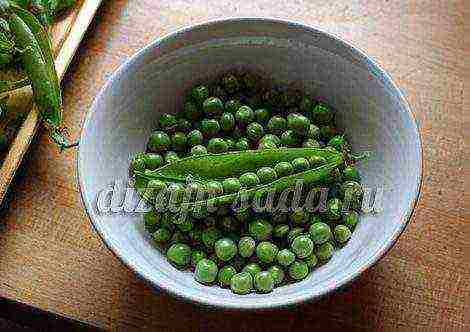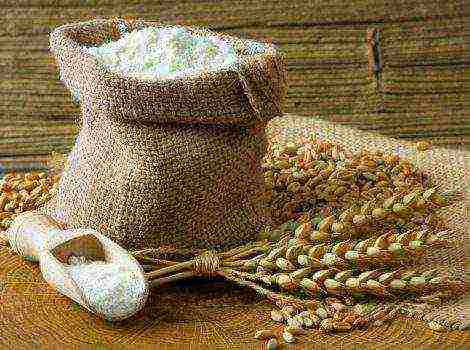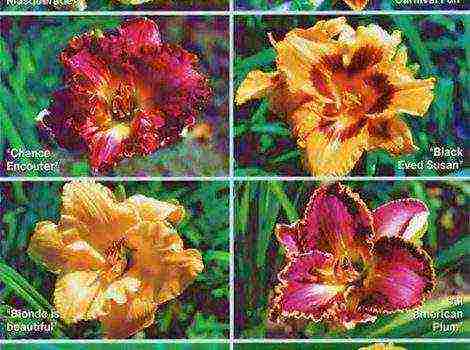Content [show]
This "sunny" berry has a wonderful taste and amazing properties. Among them are the enchanting and alluring beauty of the bunches with their expressive color, a delightful range of numerous color shades that have the best grape varieties, perfection and variety of forms of the fruits of this amazing culture. After all, it is not without reason that they say that this berry is first eaten with the eyes ...
Growing
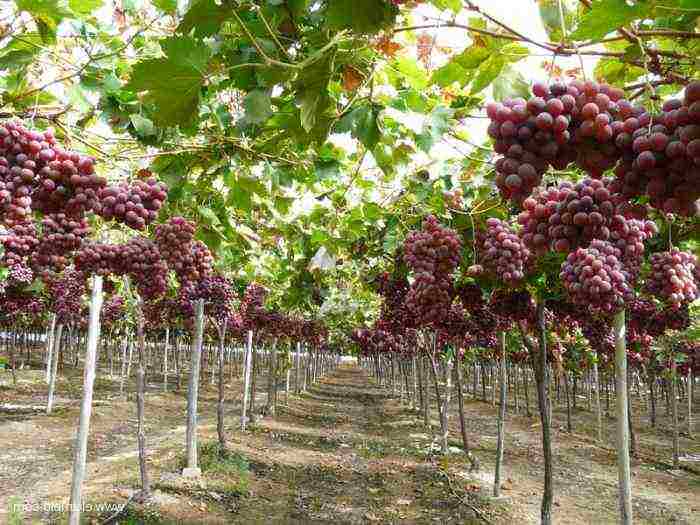 Today this crop, which was previously planted only in the southern regions, can also be seen in northern vegetable gardens or orchards. This became possible thanks to the work of breeders - they managed to create the best grape varieties, which are now grown in the North. This berry is considered one of the ancient cultures. Grapes have existed since the Bronze Age, as evidenced by numerous archaeological finds. There are bunches of it on ancient rock paintings, there are also on those excavated, including on the territory of our country, especially in the Crimea region, amphoras and jugs.
Today this crop, which was previously planted only in the southern regions, can also be seen in northern vegetable gardens or orchards. This became possible thanks to the work of breeders - they managed to create the best grape varieties, which are now grown in the North. This berry is considered one of the ancient cultures. Grapes have existed since the Bronze Age, as evidenced by numerous archaeological finds. There are bunches of it on ancient rock paintings, there are also on those excavated, including on the territory of our country, especially in the Crimea region, amphoras and jugs.
Apparently, this is why over many centuries the natural evolution of this culture took place, new best grape varieties appeared, which are distinguished by the size of berries and bunches, excellent taste, etc.
Today, in the countries where this plant grows, there are more than seven thousand of its varieties. In the countries of the former Soviet Union, the best varieties of grapes were identified, including table grapes. These are the so-called indigenous species - Armenian, Dagestan, Georgian, Tajik, Uzbek. Many of them originated in a specific area, where they were cultivated for many decades and improved in quality.
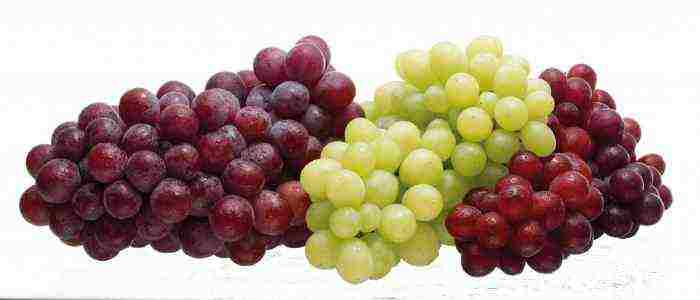 In addition to domestic ones, the best grape varieties that were imported and introduced from such European countries as France, Spain, Italy and Germany played a rather big role in the planting of this culture in our country.
In addition to domestic ones, the best grape varieties that were imported and introduced from such European countries as France, Spain, Italy and Germany played a rather big role in the planting of this culture in our country.
Nevertheless, species of “local” origin are considered by specialists to be more adapted to the natural conditions of their native territory than those that were brought in. As an example, we can bring the best Georgian grape varieties - Rkatsiteli and Saperavi, which are perfectly adapted to the Georgian climate, under the influence of which they were once formed. This is reflected not only in excellent yield, but also in excellent taste.
Views
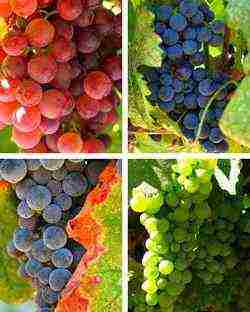 Experts say that over the past twenty years, there has been a real boom in this berry crop in our country. Breeders annually grow up to ten new products, and all of them claim to be "the best grape varieties". However, in pursuit of the size of the bunches and fruits, in some species reaching even twenty-eight grams, some varieties lose their taste and useful properties.
Experts say that over the past twenty years, there has been a real boom in this berry crop in our country. Breeders annually grow up to ten new products, and all of them claim to be "the best grape varieties". However, in pursuit of the size of the bunches and fruits, in some species reaching even twenty-eight grams, some varieties lose their taste and useful properties.
Today this culture is very common in our gardens and orchards. But, in order for its cultivation to give the desired results, summer residents first need to understand the huge variety of species, find out which are the best grape varieties that are most suitable for a particular region.
According to the ripening period, this plant is divided into late and very late, early, early-middle, as well as middle and medium-late, and by purpose - into universal, table and technical. Each subgroup, in turn, consists of a fairly large number of subspecies, many of which are indeed the best in their category. Table grapes are considered to be of the highest quality. Most amateur gardeners prefer to plant them in their garden.
Benefits of table and wine types
They have an excellent presentation in comparison with other - universal and wine varieties. Today on the market there are numerous table varieties with a wide variety of characteristics of fruits, which are consumed mainly fresh. Many species are interesting because they are cultivated for the subsequent production of wine. For amateur gourmets, the best varieties of wine grapes should differ in the following characteristics: sugar content of berries, presence of nutmeg taste, high yield of juice, and, what is important, resistance to frost and pests.
Ten
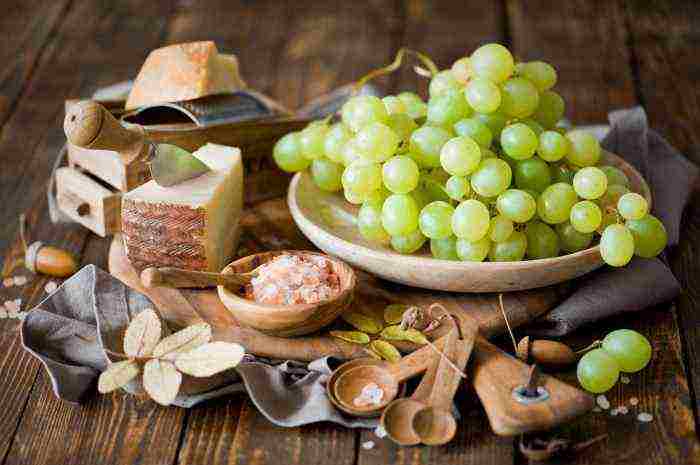
Novice gardeners and summer residents are always first of all interested in specialists, which plants to plant on their plots. A culture like grapes is no exception. And although it is difficult to reliably answer the question of the best variety, breeders mostly mention the 10 best grape varieties, although most often each of them has its own preferences and "favorites". Nevertheless, for a very long time there have been such species that have not lost their taste, are excellent for a particular region. In addition, these are the ones that most often fall into the annual nomination "the best grape varieties", their photos are most often printed in special literature, etc.
Arcadia
The variety has long been a real decoration not only for home plots, but also for large plantations. It has earned such universal recognition due to not only the high quality of the crop, but also its great stability and very easy survival rate. Being an early grape, it deservedly occupies one of the places of honor in the world's top ten assortment. Arcadia is characterized by very large clusters, weighing two or more kilograms. This table variety has a fleshy and juicy pulp, a light nutmeg aroma.
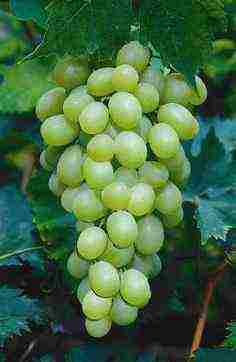
Delight
This variety is always mentioned in the top ten as one of the first. In addition, it belongs to a very early variety. In addition to resistance to disease and frost, Rapture also has one more, but rather rare and, moreover, valuable advantage: its berries practically do not crack and do not rot at all.
White kishmish
This mid-season grape, popular in our country, has cylindrical wide-brimmed clusters.They are not very large - up to three hundred grams, but with fleshy and tasty berries. This variety is considered one of the most popular. Its berries help a person get rid of irritability and stress. They have no bones at all. The skin on the fruit is thin and transparent, sometimes with small black dots. The flesh of the berries is fleshy, with a very pleasant taste.
Codryanka
This Moldovan variety has a very pleasant taste, pleasing the eye with its aesthetic forms. Very early ripening combined with high yield and high taste of its large dark purple oval berries made Codryanka indispensable for vine growers. The variety has deservedly occupied its stable place in the top ten table grapes for many years.
Lady fingers
Almost all gardeners know about this grape, which is called somewhat original. This mid-season variety with medium-sized clusters - large and elongated, is characterized by the absence of seeds and the shape of the berries - oval elongated. They are covered with a weak wax and have a moderately sour and moderately sweet taste.
Pleven

Over the years of fruiting in the gardens of our summer residents, the variety has shown the highest yield. Apparently, therefore, it is always in the top ten species. Pleven grows well on any soil, it is stable and resilient in all its characteristics. Its clusters are aligned, with identical, as if calibrated, elongated berries with a harmonious taste. The variety is in high demand in the market, and it ripens very early.
The very early elegant
The grapes of this variety have proven their right to popularity. It ripens early, withstands frost, rain and drought, and besides, it practically does not get sick. The Elegance has beautiful clusters with large, egg-shaped berries of an original shape. It is very easy to normalize it, as gardeners testify, but there are no problems with pinching at all. The bunches of the variety are not damaged, and therefore they are in steady demand on the market. It is believed that these are “grapes for the lazy”.
Laura
The variety, according to breeders, shows great promise. In the south, Laura and Rapture mature within a week. The variety has very large oblong berries of a yellowish-golden color. The pulp of the fruit is crispy and tender. Laura's vine ripens well, easily tolerating frosts up to twenty degrees. In more severe cold weather, the plant needs shelter.
Talisman, or Kesha-1
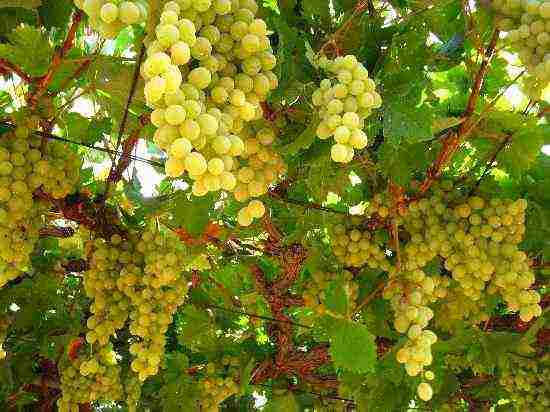 Being a "descendant" of the famous Delight and a "parent" for many hybrid forms, this variety, due to its excellent characteristics - early ripening, high yield, resistance to pests or diseases, frost resistance and vigorous growth, is very popular among both amateurs and professionals. growing grapes on an industrial scale.
Being a "descendant" of the famous Delight and a "parent" for many hybrid forms, this variety, due to its excellent characteristics - early ripening, high yield, resistance to pests or diseases, frost resistance and vigorous growth, is very popular among both amateurs and professionals. growing grapes on an industrial scale.
Strashensky
This variety withstands tough competition even with the best species. Its high drought tolerance allows it to grow and develop at a time when other forms wither, dying. The variety has round dark blue berries that grow from a medium plum, as well as huge clusters that do not even fit in a five-liter bucket. At the same time, Strashensky is sensitive to overload, therefore, it must be normalized to obtain large bunches. The variety ripens by mid-August, confirming its reputation as one of the best large-berry grapes in the world.
Review of the best table grape varieties - according to reviews of gardeners and winegrowers
Grapes are a capricious heat-loving vine. But the tasty and healthy berries justify any growing effort. Industrial vineyards are concentrated in the south of Russia, but winegrowers successfully cultivate the culture in the Urals in protected soil conditions. Whether the first experience of growing grapes will be successful depends on the correct choice of good varieties. In the Moscow region and the Middle Lane, not only the winter hardiness of the variety is important, but also the ripening period of the grapes.Forms with a long growing season simply do not have time to mature and form a full-fledged brush. We offer you an overview of the best grape varieties, compiled from the reviews of experienced winegrowers and amateur gardeners.
What are the grape varieties?
Grape varieties have a complex classification. By the type of agricultural technology and the purpose of the crop, they are distinguished technical and canteens... If the former, giving small sour berries for processing, grow well and bear fruit without fertilizers, then the latter, which form large beautiful brushes, require a high level of agricultural technology. Table varieties are inferior to technical ones in terms of resistance to major diseases.
They are distinguished by frost resistance covering and uncovering forms. They differ somewhat both in shaping and in care. This distribution is valid only for a certain climatic zone or even a region. The same grape variety in Volgograd can be grown without shelter, but in the Moscow region it already needs protection. Also, the varieties are grouped according to the color of the berries and the severity of the nutmeg in taste.
Winegrowers with many years of experience find it difficult to single out the top ten grape varieties, because each group will have its own favorites. At the same time, there are no ideal varieties without a flaw: excellent taste and a large, beautiful bunch have to pay for susceptibility to disease and a tendency to cracking. All table varieties are treated with fungicides in spring for prevention, and less resistant ones are sprayed in summer. The varieties presented below are always present at horticultural exhibitions and are most often recommended to novice winegrowers.
Rating of the best table grape varieties
The best early grape varieties
|
Laura 175 (for an annual self-rooted seedling of the 1st grade) Very early table grapes of Odessa selection. The bush is medium-sized, poorly stalked. The bunch is conical, often loose, weighing more than 1 kg. The berries are cylindrical, up to 4 cm long, weigh on average 6 - 9 g, greenish-white, sometimes with a tan. The pulp is dense, crispy, the skin is firm, thin, with a waxy bloom. Attachment to the stalk is strong, the bunch does not crumble. Berries accumulate sugars well and quickly lose acids, there is a nutmeg aftertaste. In favorable years and with good care, one plant produces 60 - 70 kg of berries. Shows increased resistance to mildew, is not affected by gray rot. Cracking of the skin is extremely rare. It is well pollinated, but does not tolerate crop overload, therefore, its rationing is required. One bunch is left in one vine. In the middle lane, it is grown with obligatory shelter for the winter. Main pluses:
Minuses:
|
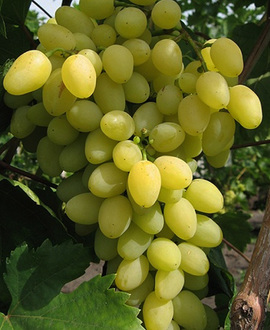 9.9 / 10 Rating Reviews Laura is my favorite grape variety. The berry is fleshy, of harmonious taste, hangs on the bushes for a long time and does not deteriorate, it is well stored after removal.
|
|
Arcadia 175 (for an annual self-rooted seedling of the 1st grade) An early ripe table grape variety with light-colored berries. The bush is vigorous. Saplings grow rapidly and enter fruiting early. In favorable years, the vine ripens well, but the overload of the crop delays ripening. The bunches are dense, weighing on average 600 g, but with good care they reach 1.5 - 2 kg, with blades, broadly conical. Berries 2.8 - 3 cm long, weighing 7 to 15 g, ovoid, amber-white. The pulp is juicy and fleshy, the skin is strong. The taste is simple, with a light nutmeg aroma at the stage of full ripening. The berries tolerate transportation well. Productivity depends on agricultural technology, method of formation and age of the bush. Responsive to agricultural practices, including fertilization. Shows resistance to mildew at 3.5 points. Average winter hardiness, refers to the covering. Main pluses:
Minuses:
|
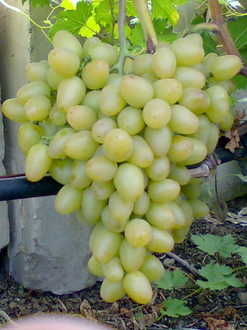 9.9 / 10 Rating Reviews In my conditions, this grape variety manifests itself in the best way. Gives large bunches, tasty berries, the skin is not rough, medium thickness.
|
|
Alyoshenkin 450 (for a two-year seedling with ZKS) A good early table grape variety of the Volgograd selection. Vigorous and highly productive, quickly takes root and adapts to the microclimate, with good maturation of the shoots. Pruning is done for 5 - 6 or 8 - 10 eyes. The bunch is loose, slightly branched, conical, depending on the care it can weigh from 500 g to 2 kg. Berries are oval, amber in color with a whitish bloom, weighing 4.5 g. The third part (in some years up to 50%) of berries without seeds, responds well to preparations for raisins. Harmonious pulp, crispy. The skin is of medium density. Winter hardiness is good, but in the Middle Lane it requires light shelter. It has good adaptive properties, the vine ripens even in unfavorable years. Due to insufficient disease resistance, it is grown with preventive treatments throughout the season. Main pluses:
Minuses:
|
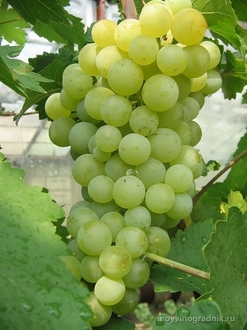 9.8 / 10 Rating Reviews We (Nizhny Novgorod region) always have strong dew in the morning, so the bush suffers from mildew. But this problem is solvable, and it has many advantages.
|
|
Somerset Siddles 200 (for an annual seedling of the 1st grade) An early seedless variety with brightly colored berries. North American selection. It is characterized by moderate shoot growth. A cluster of medium size or small, weighing 100-200 g, dense, cylindrical. The berries are round, weighing 1 - 2 g, pink. The taste is very high. Medium skin, firm, edible. Adapted for northern regions. Differs in high winter hardiness and good immunity. In regions with winter temperatures not lower than minus 20 - 25 degrees, it can be grown in a non-sheltered culture. When grown in the Ryazan and Moscow regions, the beginning of ripening is noted already in the first decade of August. Main pluses:
Minuses:
|
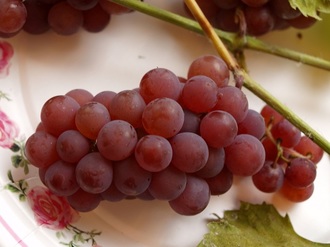 9.7 / 10 Rating Reviews For the Moscow region, I think this is the best grape variety, even in bad years it ripens until mid-August, the vine always ripens. Children have the most beloved.
|
|
Zilga 520 (for a one-year seedling in a container (ZKS)) This early ripening universal grape is good for the Moscow region and for the northern regions. The bushes are vigorous. Shoots ripen perfectly. Good compatibility with rootstocks, fast rooting. The bunch is cylindrical, with one wing, dense, weighing 300 - 450 g. Berries are round-oval, dark blue, weigh about 4 g. The flesh is slimy, the skin is thick. The taste is simple, characterized as isabella. Ripe bunches can remain on the vine for a long time without crumbling or losing flavor. Differs in resistance to gray rot, mildew and powdery mildew. Good frost resistance, but grown with shelter for the winter. It is especially appreciated for its cold resistance: berries ripen and gain sugar in regions with an insufficient amount of active temperatures for southern varieties. A positive cultivation experience was obtained by winegrowers from the Moscow and Leningrad regions. Main pluses:
Minuses:
|
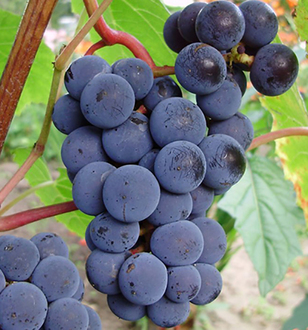 9.6 / 10 Rating Reviews The best grape variety for aspiring growers: it will forgive any mistakes. The berries are quite edible, if you do not chase the southern standards, and the wine is good.
|
The best mid-season grape varieties
|
Talisman (Kesha-1) 175 (for an annual self-rooted seedling of the 1st grade) Mid-season table grapes. With flowers of a functionally female type, it shows good pollination (in the presence of pollinating varieties) and a low degree of pollination, but with additional pollination it forms an aligned, larger bunch. Differs in active growth, shoots are thick and noticeably outperform other varieties in growth. There are many stepsons. The bunch is conical, of medium density, weighing from 550 - 800 to 1100 - 1900. The berries are round, 3 - 4 cm in diameter, amber with a white waxy bloom, weighing 12 - 16 g and more. The pulp is very sweet, with a nutmeg aroma and aftertaste. Shows high resistance to disease and frost. Due to its late ripening, it is recommended for cultivation in the southern regions. In the Volgograd region, it ripens in the third decade of August. In the suburbs of Moscow, in the open field, these grapes show poor ripening and a lack of varietal taste of berries. It shows itself well when grown in a greenhouse or with temporary shelters for "running". Main pluses:
Minuses:
|
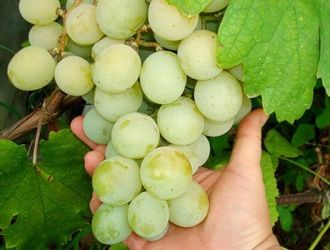 9.8 / 10 Rating Reviews It's a tricky variety to tinker with, but its berry flavor and good disease resistance outweigh its capriciousness.
|
|
Radiant kishmish 270 (for an annual seedling of the 1st grade) Seedless variety of medium ripening. The bushes are vigorous. Bunches are conical, branched, up to 40 cm in length, often with lobes, of medium density, with an average weight of 500 - 600 g. Berries are oval, 2.5 - 3 cm long, weighing 2.5 - 4 g, pink-red. The pulp is dense, sugary with a light nutmeg. Suitable for transportation and long-term storage. In the spring, the buds wake up later than the early varieties. Not suitable for growing in the Central Region. In the Moscow region, it does not ripen in the open field. In the Voronezh region, it does not collect sugar in a rainy summer. Good reviews from winegrowers from the Volgograd region, where it is grown in a covering culture. Main pluses:
Minuses:
|
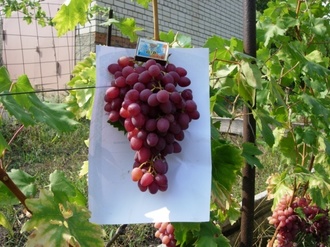 9.7 / 10 Rating Reviews Having tried the berries at the exhibition, I became very fond of this variety. Yes, it requires attention, but like all raisins, and in terms of taste and beauty, the bunches are out of competition.
|
|
Rizamat 250 (for an annual self-rooted seedling of the 1st grade) Mid-season table raisin grapes of Uzbek selection. A bush with high vigor. Requires careful shaping, removal of stepsons is mandatory. The bunch is conical, branched, of medium density, weighs 800 - 1500 g, with professional care the weight of individual bunches exceeds 3 kg. The berries are cylindrical, weighing 10 - 15 g, pink with a darker tan, with a medium waxy bloom. The pulp is tender, dense, crispy. The skin is thin. Experienced growers harvest more than 70 kg from an adult bush. Does not possess complex stability and needs frequent preventive treatments. Ripening berries attract wasps, so the clusters protect. After heavy rains, the skins of the berries are cracking. Forms high yields on condition of high soil fertility. Due to the low frost resistance, even in the Middle Lane, a good shelter is needed; in the Moscow region, it is more often grown in greenhouses. Main pluses:
Minuses:
|
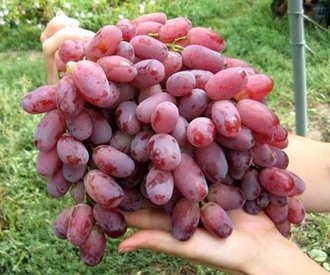 9.7 / 10 Rating Reviews The variety definitely justifies the increased attention to itself. All care efforts are paid off by a large and beautiful berry with a delicate taste and crunchy pulp that simply melts in your mouth.
|
The price of grape cuttings is 2, and sometimes 4, times lower than the price of ready-made seedlings. Depending on the variety and manufacturer, cuttings can cost from 50 to 300 rubles.On the forums, you can find private winegrowers who will share several cuttings for free. But planting a cutting implies both meticulous care and big risks.
Have a nice harvest!
Attention! The reliability of the information and the results of the ratings is subjective and does not constitute advertising.
People began to grow grapes more than six thousand years ago. It comes in two varieties - technical and dining. The first group includes varieties that are used for the manufacture of juices and the production of alcoholic beverages - wines and cognacs, the second group - table species.
What grapes are called table grapes?
Distinctive features of such grapes are beautiful appearance and high taste. Large sweet clusters are eaten fresh, without processing. They tolerate transportation well. The berries have few seeds, thin skin and fleshy flesh. The most popular and elite grape varieties are presented below.
The most popular and best varieties
Arcadia
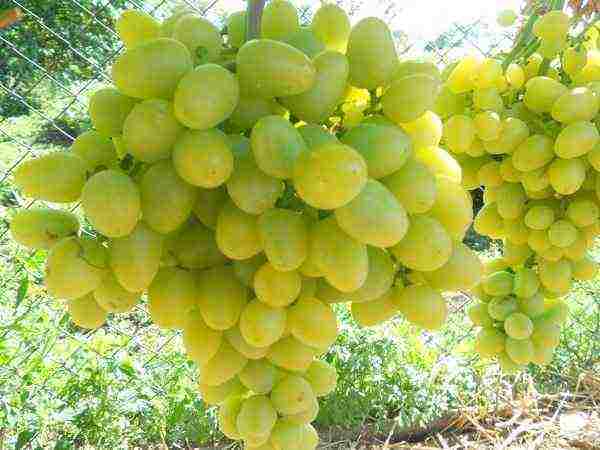 Grape variety Arcadia
Grape variety Arcadia
The result of crossing Moldova and Cardinal, combined the successful properties of their parents. Consumers appreciate large bunches that can reach two kilograms, and gardeners appreciate resistance to low temperatures and high immunity. Juicy light pulp of berries captivates with a delicate sweet taste and aroma of nutmeg when fully ripe. This early variety is the leader in yield, if you normalize the number of inflorescences, feed the bush in time. An excess amount of moisture can lead to cracking of ripening Arcadia berries, so watered with caution, taking into account weather conditions.
Delight
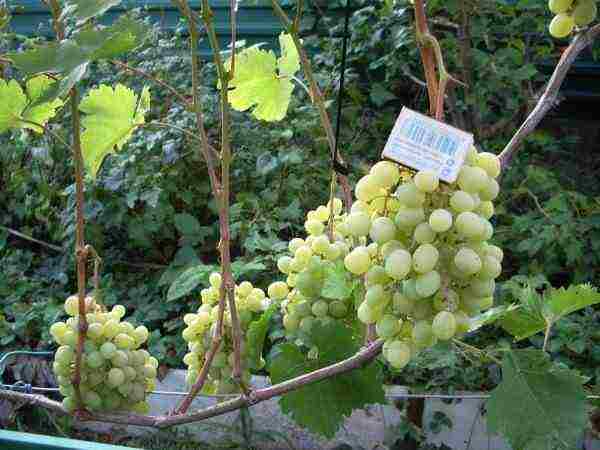 Grape variety Delight
Grape variety Delight
Very early ripening variety. The berries are large, with a refined nutmeg taste and a loose skin with a waxy coating. The vine can withstand temperatures up to 26 ° C frost, therefore, cultivation in the northern regions is allowed. The high immunity of the Delight variety helps fight fungal diseases and mildew, but you need to treat the bush from phylloxera. The yield is high, the fruits can be left on the bush for up to 1.5 months after ripening, while the taste remains excellent.
Experienced gardeners claim that this grape has no drawbacks.
White kishmish
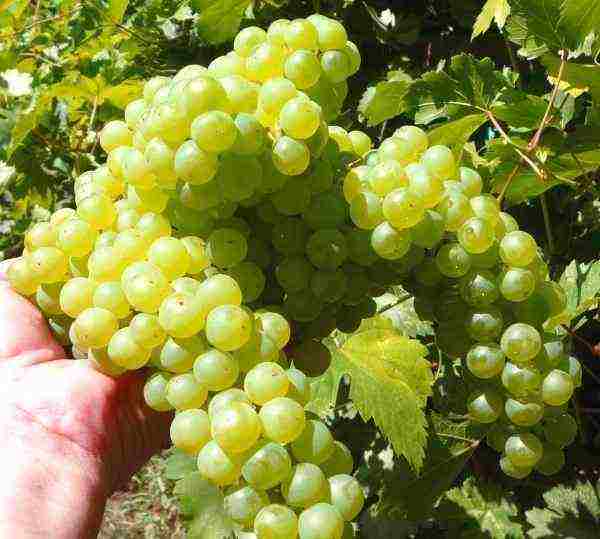 White Kishmish grapes
White Kishmish grapes
An ancient dessert type with a medium ripening period. The bunches are small. Seedless small oval berries, juicy, very sweet and not tart. Their skin is thin and transparent. Due to their fragility, the fruits are not stored for a long time and have low transportability. After harvesting, they must either be eaten immediately, or used to dry raisins. Dried fruits made from Kishmish are a tasty and healthy delicacy. The vine is powerful, but the yield is low. Average frost resistance. Requires protection from pests and diseases. Needs crop pruning and rationing.
Kesha
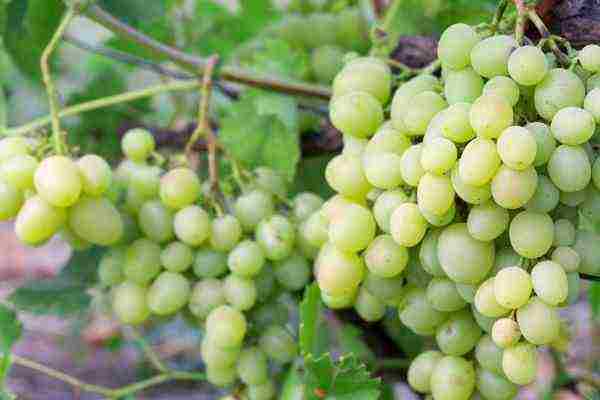 Kesha grape variety
Kesha grape variety
Improved Delight with beautiful brushes. White berries are sweet, with a slight sourness and 2-3 large seeds... Kesha is a medium early variety, very tall, with excellent transportability and frost resistance. It develops well if it has a supply of perennial wood. Will appreciate planting in a sunny place and fertile soil. Moderate watering, thinning bunches, and regular fertilizing have a beneficial effect on yields.
Strashensky
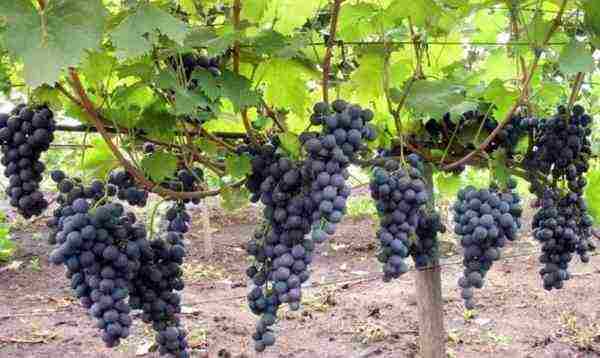 Grapes Variety Strashensky
Grapes Variety Strashensky
Handsome man with black berry, medium-early ripening. The fruits are juicy, the grapes are delicious. Bunches of medium density, high-quality type, usually weigh up to 1 kg. Poorly tolerates long-term transportation, average winter hardiness. There is uneven ripening, so the crop is cut selectively. The load on the bush will decrease, the remaining fruits will pick up sugar well. This variety has a reduced resistance to gray mold and powdery mildew, but is good at fighting phylloxera, mildew and spider mites. Needs pruning, depending on the growing region.
Laura
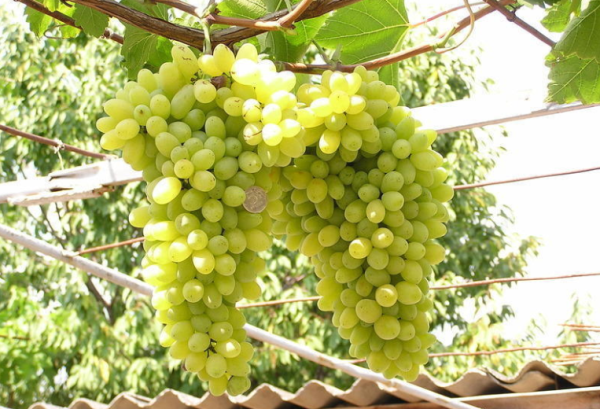 Laura grape variety
Laura grape variety
Table form of grapes of the superearly ripening period. Amber pulp contains a lot of sugar. The taste is rich, pleasant, with nutmeg notes. Large beautiful clusters are a distinctive feature of the variety, some record-breaking brushes weighing up to 2.4 kg. High transportability, popular with buyers and suitable for beginner winegrowers. Resists mildew and gray rot, withstands temperatures up to 20-23 ° C frost. The Laura variety needs pollination during flowering and medium pruning, while preserving perennial wood. The bush is loaded optimally, leaving 30% of non-fruiting shoots. Such a plant will have the strength to form beautiful large brushes that will ripen on time.
Moldova
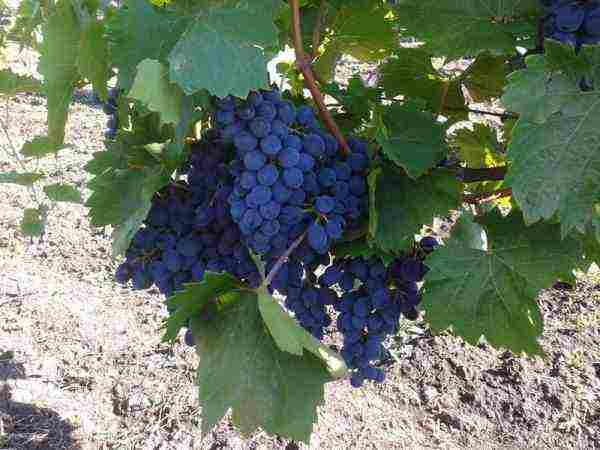 Grapes variety Moldova
Grapes variety Moldova
A time-tested species, purple berries with a waxy bloom. The bunches are medium in size, the fleshy flesh has a simple taste. Ripening dates are late or medium late. Frost resistance is not very high. Requires careful shaping of the bush - a vigorous vine does not like thickening. Perfectly resists fungal diseases and phylloxera, treatment is needed only against powdery mildew. There is an increased sensitivity to calcareous chlorosis. Used for growing on a gazebo, the bunches retain their decorative appearance and pleasant taste for a long time on the bush. It tolerates transportation well.
Timur
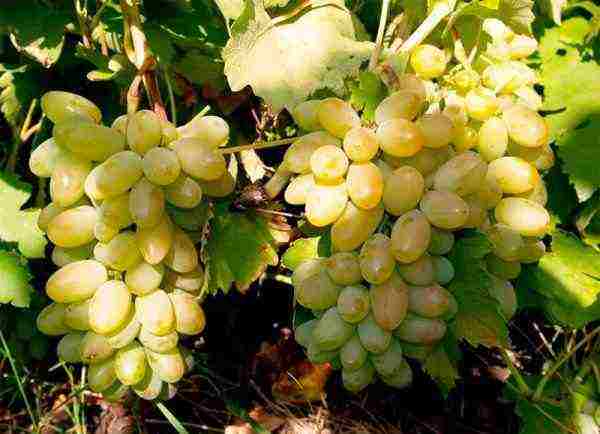 Grape variety Timur
Grape variety Timur
An early ripening hybrid. White berries with a nutmeg aroma, a slight amber or slightly brown tan appears in the sun. The brushes are medium in size, dense. Cuttings give a small "trial" crop already in the second year after planting. High frost resistance and resistance to gray rot and mildew. Timur grapes often fall prey to ticks. If the leaves "swell" and redness appears, you need to treat the grapes with a sulfur-containing preparation. Experienced growers praise Timur for the ease of cultivation and early maturation. Care consists in regular watering, feeding and pruning.
Lady fingers
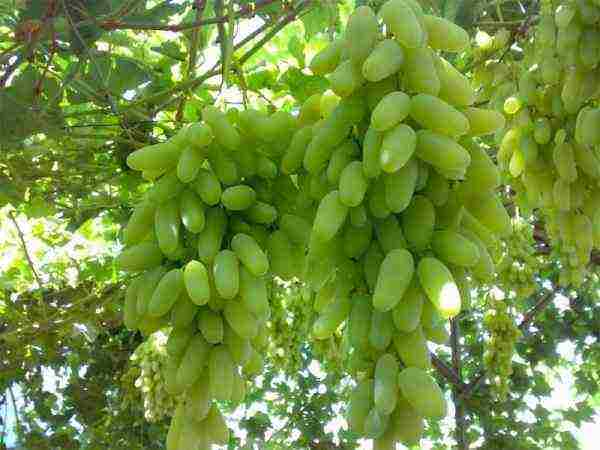 Grape variety Ladies fingers
Grape variety Ladies fingers
An old mid-season variety, which, despite the difficulties in its care, continues to be grown by many growers. The weight of one hand is about half a kilogram. Berries of the Ladies' fingers are elongated in shape, with a classic harmonious taste and mouth-watering aroma, pitted. Not resistant to low temperatures, can die already at 10 ° C frost, therefore needs shelter for the winter. Productivity is changeable, depending on weather conditions. The vine is sensitive to diseases and pests; regular treatment with appropriate preparations is necessary. Recommended for experienced gardeners.
Gourmets consider this variety to be the standard of grape taste.
Mascot
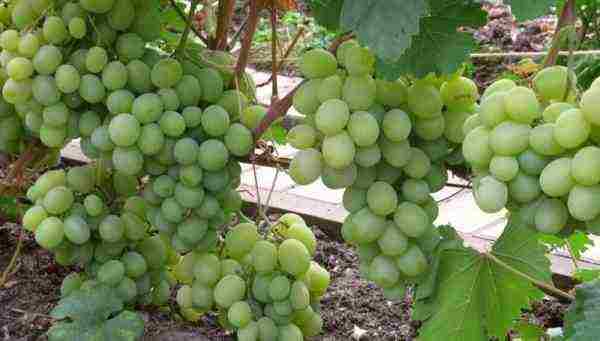 Grape variety Talisman
Grape variety Talisman
Mid-early grapes are yellow-white in color. Vigorous seedlings are excellent resistance to mildew and gray rot, and are resistant to low winter temperatures. Ripe bunches weigh a little more than a kilogram on average. The fruits are large, with a nutmeg aroma. Already ripe brushes can hang on the bush for a long time without losing their taste and retaining their marketable appearance. A transportable variety that does not require shelter for the winter. A record harvest can be achieved with proper agricultural technology and additional pollination before flowering.
Grapes are a wonderful gift of nature, a child of the gentle sun and fertile land. There are no ideal varieties, but you can always find a species that suits the growing conditions and personal preferences of the gardener.
For modern gardeners of the southern and northern regions of our country and neighboring countries, there are no problems with the choice of grape varieties and varieties due to the variety of dessert and technical types of thermophilic culture. A vine with fruits of different shades and sizes, having a unique taste and aroma, with proper care, allows you to experiment on the garden plot and grow adapted grape hybrids,bred in the last decade by Russian and foreign breeders.
The best dessert grape varieties with a description and a brief description
Growing a decent harvest of early-maturing varieties in the Ural vineyards, in Bashkiria or in Siberia and the Far East used to be a wonder, now it is a common phenomenon, spreading even among inexperienced gardeners. In the southern regions of our country and in Ukraine, mid-season and late table and universal varieties of thermophilic culture are successfully grown. Knowing the peculiarities of agricultural technology, amateur gardeners of the Moscow region and St. Petersburg have learned to grow wine grape varieties intended for open ground, rare dessert varieties of grape vines with specific cultivation features. Most often, novice gardeners do not attach importance to the names of hybrids, preferring to work on "white" and "black" grapes. But knowing the names of species and varieties of grapes with white, dark purple and pink fruits, you can easily understand the agricultural technology of culture and adapt to their characteristics.
The best varieties of white dessert grapes
White-fruited table grapes are good both fresh and processed for compotes and jams. New varieties, developed by breeders, make it possible to obtain large, juicy berries of early and mid-season varieties in the southern regions and in the harsh northern ones. A vine with milky white fruits is a natural phenomenon, the result of a mutation of wild-growing grapes that have lost the ability to produce anthocyanins, which are responsible for the dark color of the berries..
To select the best grape varieties, they are judged according to the following criteria:
- yield;
- quality characteristics of fruits (sugar content and acidity);
- resistance to diseases of the vine;
- frost resistance.
Each person has their own preferences. Sometimes large, beautiful berries of modern breeding varieties with a fresh taste may seem unclaimed and ordinary to someone, these gardeners prefer sweet, but small and loose clusters of raisins. For other grape lovers, not only the qualitative characteristics of the berries are important, but also decorativeness, the adaptation of the vine to certain climatic conditions. There are dozens of the newest varieties, which are still difficult to evaluate, but they are already distinguished by high yields and a bright, rich taste of fruits.... For example, Atlantic, a dessert variety with pink, elongated fruits, juicy and aromatic, with floral-fruity notes; nutmeg variety Silver; Alibaba with harmonious berry taste and black-fruited Carmen; an unusual variety Zephyr with raspberry-pink tassels and a Rostov hybrid Anyuta with the aroma of a tea rose and dense pulp.
Photo Gallery: Latest Grape Hybrids
The leading varieties of white-fruited grapes include:
- Arcadia is an early ripe variety, bred in Ukraine (crossing of Moldova and Cardinal), has dense clusters up to 2 kg. A vigorous plant does not suffer from overload and gives an excellent harvest in central Russia and Siberia, the Urals and the Far East. Ripening period 105-115 days. Berries are light green, with dense, juicy pulp, sweet with moderate nutmeg; 2-3 bones are found. Pruning is carried out for 8-12 buds, processed at least 2 times a season from powdery mildew.
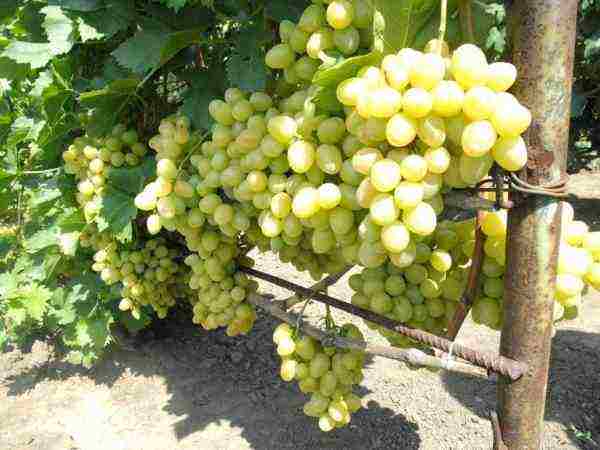
Early ripe grade Arcadia
- Laura (Flora) - a hybrid obtained more than 20 years ago, with light milky oval berries and a pointed tip of the fruit. Crispy, moderately sweet with a pronounced nutmeg aroma. Bunches grow up to 900 g, ripening period - 110-115 days. A medium-sized stem develops well with fan molding, begins to bear fruit for 4 years; trimming for 8-10 eyes. The variety is valued for its frost resistance and for the absence of peeling and cracking of the fruit.
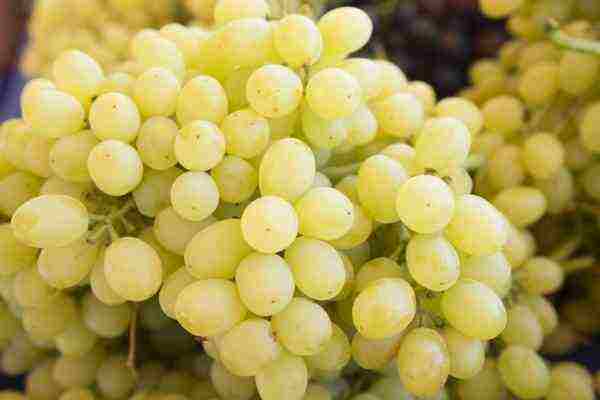
Laura table white grapes
- White kishmish (seedless) is an early ripe variety with round berries, aromatic and juicy. Fruits are light green, when ripe - with a blush.The bunch is loose, large, weighing from 500 to 1200 g. The berry is loved for its balanced composition of sugar and acids, they are excellent for drying, freezing and do not contain seeds. A medium-sized plant finally ripens at 140–160 days. Requires trimming for 7-10 eyes. The variety is cultivated in central Russia and in the south.
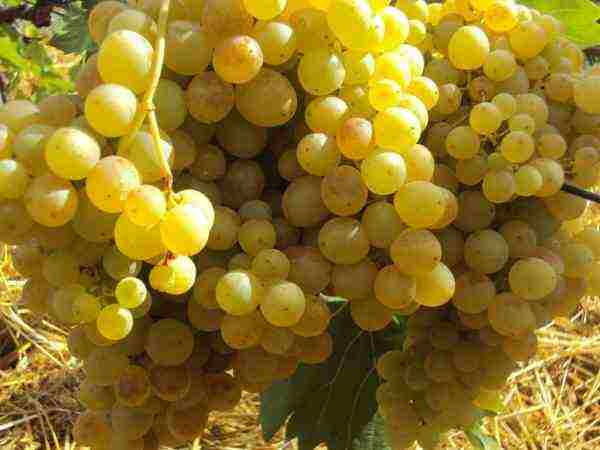
The sweetest white grapes White Kishmish
The varieties of Kishmish include the hybrid variety Volodar (early) with large, dense clusters and yellow-green fruits; and Kishmish 342 (Hungarian), obtained as a result of crossing Vilar Blanc and Sidlis Perlet, is an ultra-early variety with elongated fruits of a milky green shade with a tan, sweet and aromatic. The berries retain their presentation for a long time and do not fall off. Varietal varieties of white-fruited grapes of the subspecies kishmish - Zolotse, Talisman (Kesha), Arsenyevsky are considered no less valuable.
Photo gallery: white fruit varieties of dessert grapes
The variety White CoKl of domestic selection, which appeared in the 21st century, firmly tolerates frosts down to -25 ° C and is not damaged by powdery mildew. Powerful bushes are cut into 10 eyes and try not to overload. Then the large, oblong fruits will be sweet and moderately firm. The weight of grape clusters is from 400 to 700 g.
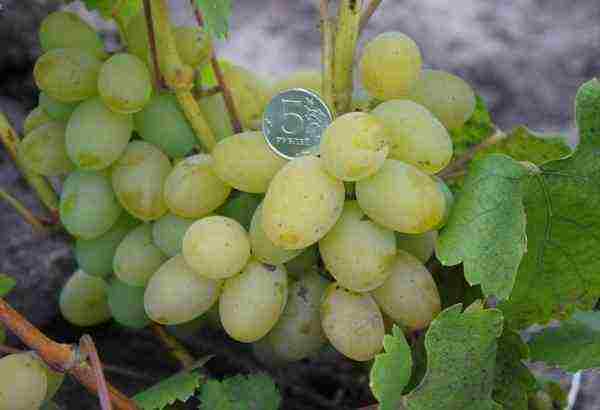
Modern hybrid White Cockle
A hardy and productive variety, Delight quickly takes root and begins to bear fruit in the 4th or 5th year. The early ripening hybrid is thermophilic and responsive to feeding. The result of the gardener's painstaking work will be huge dense clusters weighing 800-1600 g with sweet, large yellow-green berries with a pronounced nutmeg taste. Despite the short pruning, up to 30 kg of the crop is obtained from the bush.
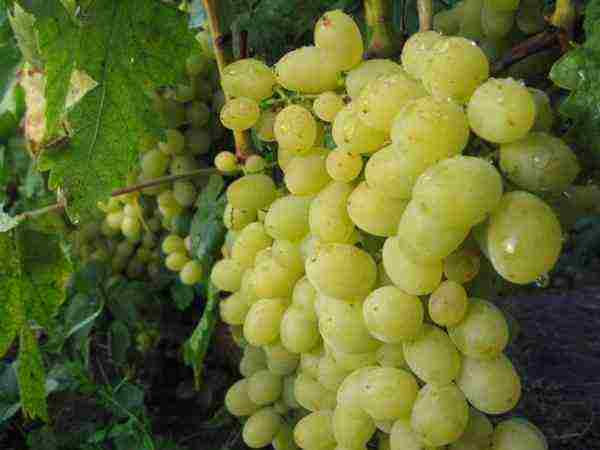
Large-fruited white grapes Delight
In a modern vineyard, Platov's late Jubilee is sure to be met with a harmonious, pleasant taste. For 125–140 days, the bunches grow on average 700 g. The Kostrykin Memory Hybrid became famous for its unpretentiousness and moderate growth of shoots (the vine ripens by 50%). The plant, with a yield of up to 15 kg from one bush, sometimes peas, but is not damaged by wasps and does not require shelter in the middle lane. The average bunch of grapes grows up to 1600 g. Ladies finger with moderate acidity will delight not only with its decorative bunch, but also with delicious fruits. Average weight of brushes - 900 g.
Photo gallery: the best white grapes
The most delicious pink grapes
Hybrid varieties and varieties of pink-fruited vines are attractive in appearance and do not disappoint in taste characteristics. Berries can be from pale pink to deep raspberry shades, so such grapes are often added to wine and canned.
- Early Russian - an unpretentious early ripening variety of dessert grapes ripens at the end of July, loose clusters on average gain up to 600 g. The hybrid grows in the south, the Far East, Bashkiria and Siberia. Light nutmeg with an admixture of caramel aftertaste is loved by every gardener of the middle lane. Rounded, dark pink berries on a tall bush gain sugars - 22%, acids - 7 g / l. 2-3 inflorescences are left on the shoots. The fruit is sometimes cracked and damaged by wasps.
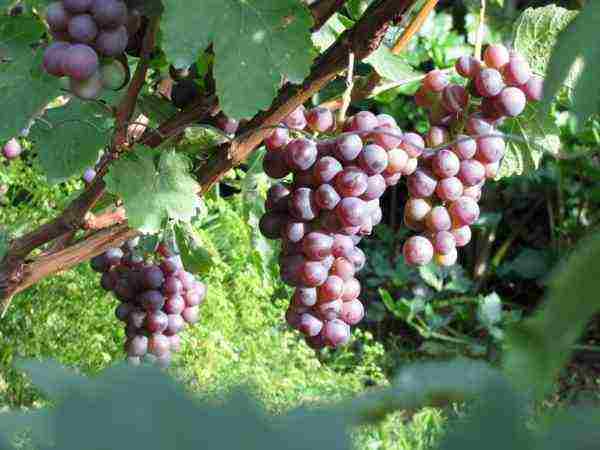
Early Russian grapes grows in many regions of our country
- By crossing Kesha and Rizamat, breeder Kapelyushny bred an ultra-early variety (ripening period of 95 days) Julian, which in less than two decades became popular and fell in love with many winegrowers for its unusual taste and shape. A hybrid with pink, elongated berries, weighing up to 20 g alone, and a powerful vine, grows best in a sunny area; it is cut into 8-10 buds. Juliana's fruits are juicy and moderately sweet, with light fruity notes.
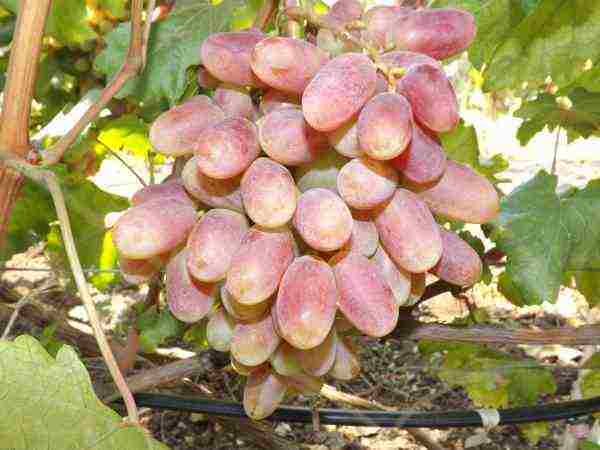
Ultra early grape hybrid Julian
- Tason is an early domestic variety with pale pink, oval, medium-sized berries, crunchy, juicy pulp, with a delicate fruity-honey aroma; the view was developed by specialists of the VNIIViV named after Ya.I. Potapenko. The hybrid is appreciated for its yield - up to 35 kg per bush with an average bunch of 800 g.Ripening period - 110-120 days. Pruning vines - 10-12 eyes. Be sure to carry out processing from powdery mildew and mildew.
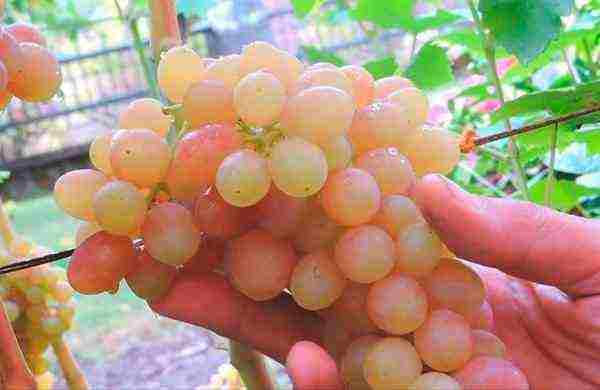
Delicate Muscat of Tason grapes was appreciated by many gardeners in Russia
- Hybrid Transfiguration - these are uniformly colored pale pink, oval berries with a thin skin and juicy pulp. The variety from Krainov's "troika" (Anniversary Novocherkassky, Victor, Preobrazhenie) is loved for its unpretentiousness and high degree of adaptation to many climatic features. Therefore, the Transfiguration is grown in the conditions of the Siberian summer and in Bashkiria, where the berry has a more intense crimson color. Bisexual flowers are perfectly pollinated. A vigorous plant with regular feeding gives a stable yield - 1–1.5 kg per bunch of grapes, up to 40 kg of selected fruits are harvested from one plant.
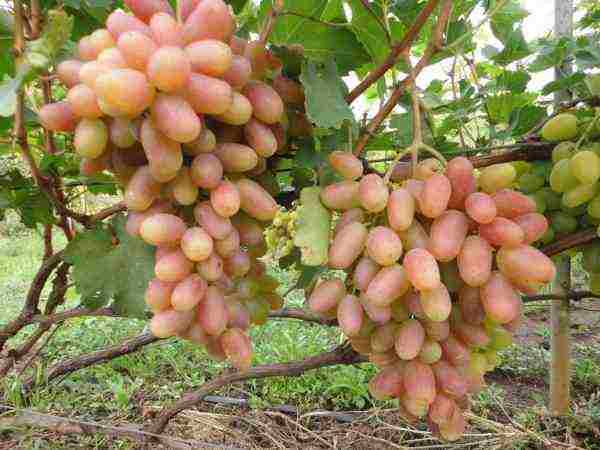
Leader of the "Krainov Troika" - grade Preobrazhenie
- Libya is the brainchild of V.V. Zagorulko, bred in the 90s. The variety is very sweet (sugar content - 26%), aromatic, non-capricious. Peat irrigation and powdery mildew are rare. The berries are oval, pink-purple, with fleshy, nutmeg pulp and thin skin. Ripening period 105 days. The flower is bisexual. Shoots are cut shortly, for 4-6 buds. Among the shortcomings, shedding of ripe fruits and damage by wasps were noted.
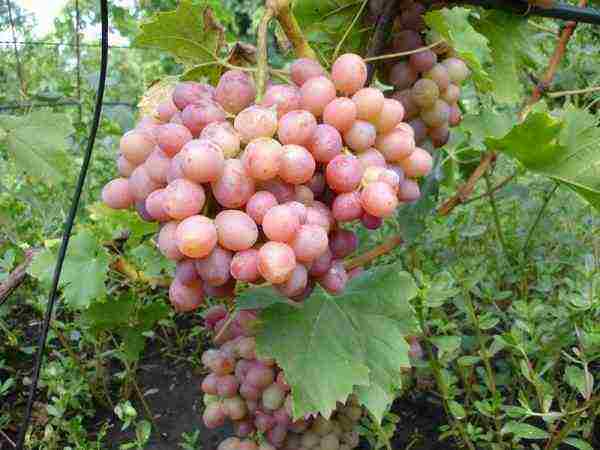
Super early variety Libya
- By crossing Kesha and Rizamat, breeder Kapelyushny bred an ultra-early variety (ripening period of 95 days) Julian, which in less than two decades became popular and fell in love with many winegrowers for its unusual taste and shape. A hybrid with pink, elongated berries, weighing up to 20 g alone, and a powerful vine, grows best in a sunny area; it is cut into 8-10 buds. Juliana's fruits are juicy and moderately sweet, with light fruity notes.
Veles also stands out among the dessert grape varieties. The “parents” of the hybrid are Rusbol and Sofia, amazing in taste and with a stable yield. Veles berries are large, oval, intense pink with a purple tint, the flesh is amber, the skin is moderately dense. There are rudiments in the berries. Veles was appreciated for the muscat-floral aroma of the fruit and the very early ripening period of the first berries - up to 100 days. Vigorous bush, pruning - medium (6-8 buds); sugar content - 23%, acidity - 5 g / l. Covering variety builds up brushes up to 1.8 kg, sometimes more than 2 kg. The fruits are prone to cracking and shedding.
Hybrid Victor from Krainov's "troika" has received attention due to its strong immunity to many diseases of grapes. Winegrowers have long fallen in love with the berries of the variety, which have an unusual shape and with a bright, nutmeg taste and floral notes. Irregularly colored pink-red finger fruits with juicy pulp ripen 110 days from the beginning of the growing season. The average weight of a bunch is 700 g. The yield reaches 10 kg from one grape bush. To obtain a stable harvest, they practice pruning by 4-6 buds and a moderate load during fruit formation. The main advantages of the hybrid form are high sugar content and transportability.
Asian hybrid Rizamat with finger-like, large (15–20 g), violet-red berries, distinguished by large clusters - from 1 kg to 2.2 kg. Ripening period - 125 days. The heat-loving variety is intended for cultivation in the southern regions, the fruits are moderately sweet, with a light nutmeg; the vine is powerful, pruned into 8-10 buds. Despite the usual taste, Rizamat is loved for its high yield and beautiful grape clusters.
Delicate pink, oval berries of the Gourmet variety in southern latitudes ripen at the end of July, in the middle lane - at the beginning of August. Author's stamp V.I. Krainova is powerful, branched, with a yield of up to 10–12 kg per plant. When tasting the fruit, fruity notes and a floral-honey aroma are especially noticeable. The grape variety Rumba of the Rostov breeder Kapelyushny is similar to this hybrid; it ripens even earlier than the Gourmet (Red Delight + Cherrel). GF Rumba is very sweet - 23% sugar, with a share of sourness - 6 g / l. Fragrant, juicy berries are perfectly preserved and are not damaged by insects due to the tart, waxy skin.
On a par with these early ripening hybrids in terms of taste, I would like to add V.V. Zagorulko - Sofia, in which the best qualities of two famous varieties are collected - the large-fruited Arkadia and the unforgettable nutmeg of Radiant Kishmish. Sofia are large, dense clusters (up to 1.5 kg) with pink-purple conical berries, most often they do not contain seeds.
We love Krainov's pink peach breeding for frost resistance and mildew resistance. Flowers are bisexual. The grape clusters of the hybrid are loose, grow up to 1.2 kg, berries with a flavor of nutmeg ripen at the end of August. The variety does not tolerate overload and is picky about feeding. With improper care, the berry becomes smaller and sour, but this does not detract from the advantages of a plant that brings a decent harvest equally in Central Russia, the Urals and Udmurtia.
But also one cannot leave aside the varietal grapes Flamingo pink, similar in shape and taste to Pink peach - with oval, pinkish-red juicy berries and loose clusters up to 1 kg. A hybrid from Moldova requires pruning for 4–6 buds and does not need shelter for the winter (in the south and in central Russia).
Photo gallery: the best pink-fruited grape varieties
Rose-fruited grapes Arched, like the hybrid form of the Original, are similar in fruit size. Arched ripens at the end of August, berries with light nutmeg contain sugars - 18%, acids - 4–5 g / l; juicy, with floral notes. Original grapes - late variety, fruits are rich in sugars - 22%, moderate acidity - 6 g / l. The pulp is watery, but sweet, with a simple taste. These varietal hybrids are practically unaffected by peas. Moderately sweet Aroky is usually used for wine.
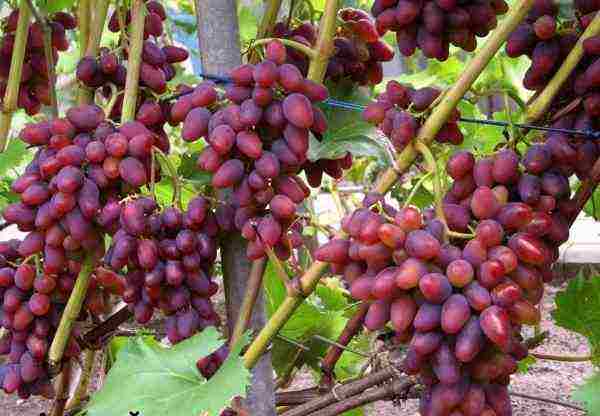
Vigorous variety Arochny
The dense grape clusters of the Original variety with conical berries and a bright purple color are stored in a cool room for more than 4–5 months.
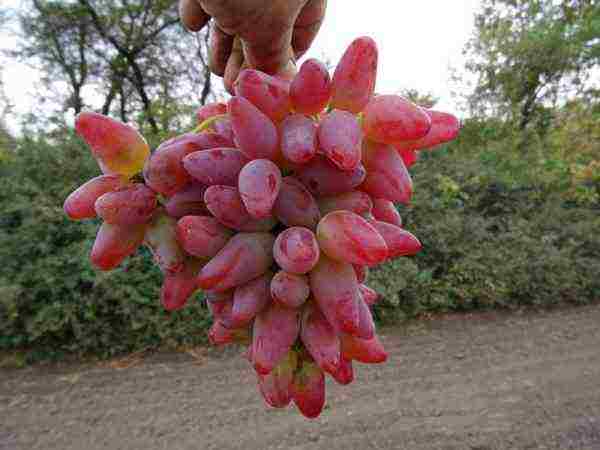
Unusual in shape, tasty and sweet berries of the Original variety are stored for a long time
The best varieties of black dessert grapes
Black-fruited grapes, in comparison with their light-colored "brothers", contain the most monosaccharides and vitamins, are excellent for conservation and winemaking, and seedless varieties are ideal for making raisins and jam. The bright, intense color of the bunches, rich in anthocyanins, serves as a decoration for the garden area.
Most amateur gardeners among dark-fruited grape varieties choose the following modern hybrids.
- Baikonur is an early ripe species - the brainchild of the domestic selection of E.G. Pavlovsky. Dense, voluminous bunches up to 1.2 kg fall on the table at the end of July. The crunchy pulp of dark blue berries with thin nutmeg contains up to 3 seeds, is rich in sugar - 21%. The fruits are able to hang on the bushes for a long time and not crumble. The variety ripens in Udmurtia and Siberia and requires shelter for the winter.
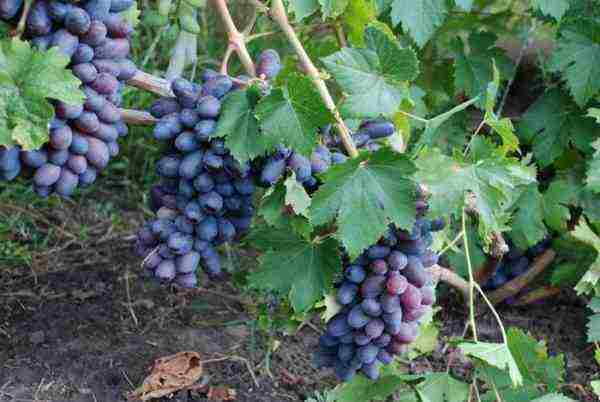
Early ripe Baikonur with blue fruits
- The early variety Codryanka with nutmeg flavor and sweetness is loved by 23% for its abundant fruiting and beautiful clusters. The time-tested variety grows on any soil, provided that the plant is regularly fed, watered and treated against powdery mildew. The weight of the grape clusters is 0.8–1 kg, the berries are dark purple with thin skin. The hybrid is cultivated in most regions of Russia - in the southern regions and in the north, in Transbaikalia and in the Urals.
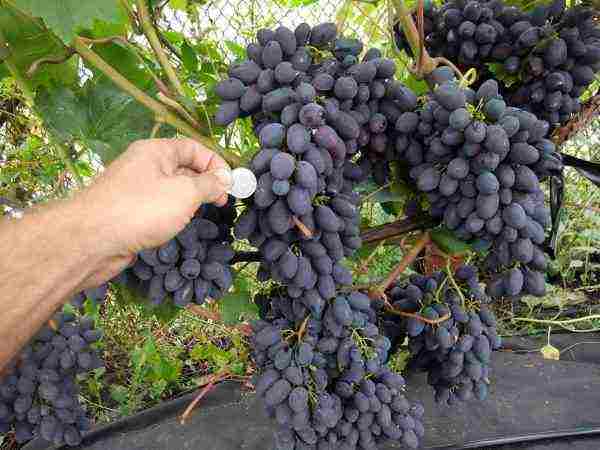
Dark-fruited hybrid Kodryanka
- The unpretentious Russian hybrid Nadezhda Azos (Moldova + Cardinal) is considered the most delicious black grapes. Dark blue, sweet-sour (sugar - 17%, acid - 7%), the fruits are covered with a thin skin, protection from wasps is required. The delicate nutmeg and juicy flesh justify the rare peas of the hybrid plant. The weight of the bunches is 800 g, the ripening period is 125 days. Pruning for 4-6 buds.
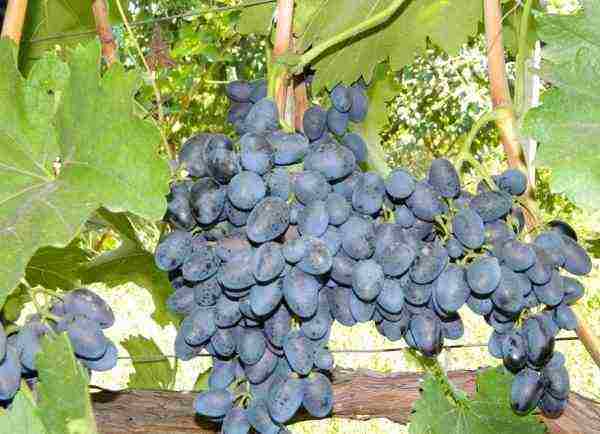
Russian hybrid Nadezhda Azos
- Super early Athos ripens on the 95th day from the beginning of the growing season, the shoots are cut into 7 eyes. A ripe bunch of hybrid forms reaches 1500 g, the variety rarely suffers from insects and powdery mildew. Large blue-black fruits grow on cylindrical bunches, suitable not only for fresh consumption, but also in wines, jams, compotes. The yield of one plant is 15-18 kg.
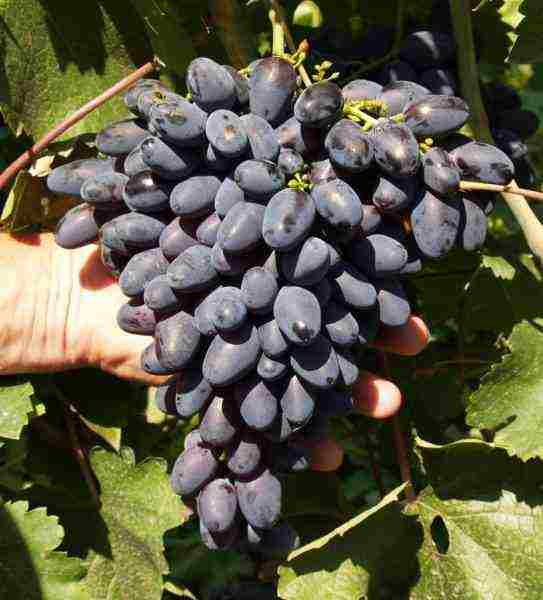
Frost hardy and drought tolerant, Athos
- Surprisingly large, elongated fruit of grapes Odessa souvenir, received in Ukraine. The berries, blue with a black tint, are covered with a waxy coating and contain 4 seeds. The hybrid ripens in early autumn (brush weight - 0.5–0.8 kg). The berries are distinguished by keeping quality, when overexposed on the bush, they do not crumble. Sugar content - 16%, acidity - 6g / l. Flowers are bisexual. Shoots are cut into 8 eyes. Used in winemaking and homemade preparations.
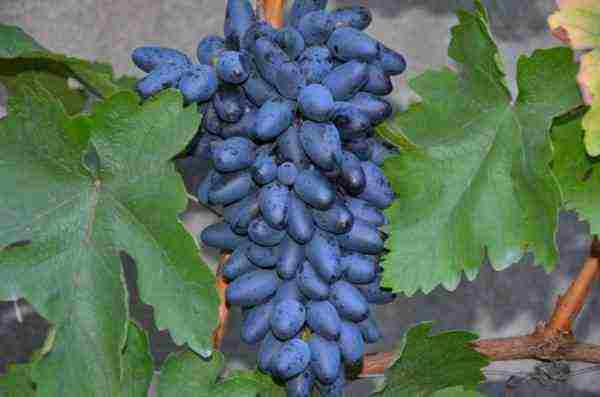
Sweet berries of the Odessa souvenir variety are a little sour and are suitable for making wines and compotes
Among the dark-fruited varieties, some also consider Black Delight (Dolores + Early Russian) the most reliable and productive, which ripens after 110 days. The variety is successfully grown in Siberia and the Far East. A vigorous bush grows on the arches, the brushes are harvested at a weight of 0.6–0.8 g. The Asian variety Black Kishmish (Talisman + Glenora) also earned a high rating among winegrowers. Oval dark blue fruits contain a moderate amount of sugar, they are often used for drying and in compotes. The fruit does not contain seeds. The variety is poorly resistant to mildew infestation. Ekaro 35 is considered the earliest black grape, the berries are purple, round; clusters weigh an average of 400 g. Fruits are rich, sweet, with a specific floral aroma.
Photo gallery: the best black grapes
Black finger is a foreign seedless variety with elongated blue berries with a delicate nutmeg taste, appreciated for the impressive size of the fruit. The heat-loving variety does not tolerate waterlogging, the amount of sugar is 19%, acid is 7 g / l.
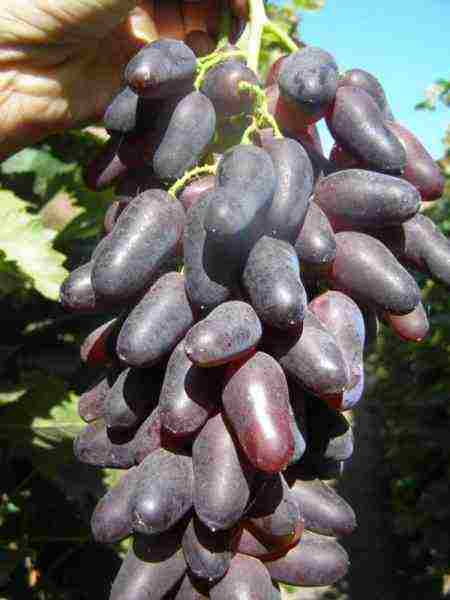
Bunch of Hybrid Black Finger
A relatively young American variety Jupiter with an isable taste and pleasant sweetness, they managed to fall in love with their excellent taste (sugar - 21%, acid - 5 g / l), cone-shaped fruits and expressive bunch shape. Trim for 8 eyes. The early ripe hybrid has relatively small (300–500 g) conical clusters. When overripe, the berries soften and lose their taste.
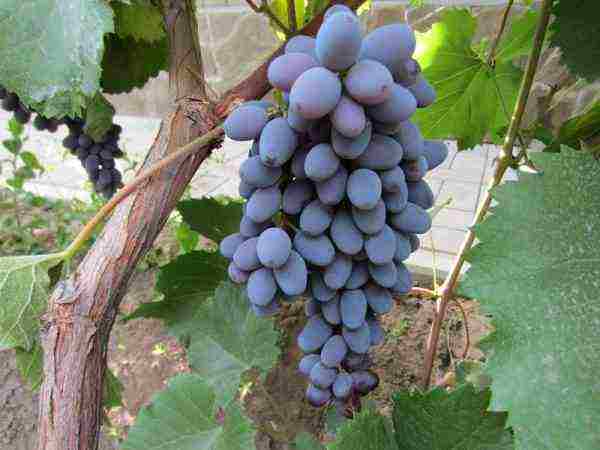
"Overseas" hybrid Jupiter
Black cherry of amateur selection by Vishnevetsky was bred a little over 10 years ago. Among the early varieties, the very first ripens (95–105 days). The weight of the fruit clusters is 400–700 g, the taste is cherry-silk, the flesh is firm and juicy. Berries do not crack, do not crumble; the hybrid is resistant to disease.
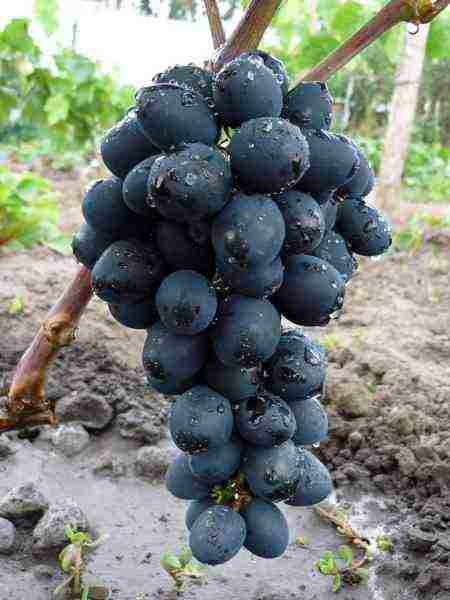
Hybrid Black Cherry
Description and brief characteristics of the best technical (wine) grape varieties
Technical grape varieties, regardless of ripening periods, are raw materials for winemaking... Depending on the intensity of the color and size of the fruit, grapes are used for the preparation of wines and cognac drinks (rose-fruited and black grape varieties more often), for compotes, preserves, jams; for the preparation of raisins, candied fruits, concentrated juices - both white and dark grape varieties.
The most common and widely known table and technical variety is the Isabella grape. Violet-blue, round berries, tightly sitting on a bunch, are distinguished by a high yield - up to 50 kg per bush. Juicy, medium-sized fruits with a specific isable aroma (usually berry-refreshing taste) ripen in 140–160 days. A vigorous bush requires short pruning (5 buds) and a sunny, wind-protected area. In general, the Isabella wine variety is undemanding and resistant to many diseases. 16 -17% - sugar, 5-6 g / l - acid - in the flesh of the Isabella variety. Gives an excellent harvest in Central Russia, the Urals, Udmurtia, Bashkiria.

Technical grade Isabella
Another variety intended for winemaking, Vesta, is appreciated for its excellent wintering without shelter and high yields even in cold, damp summers. Sugar content - 25%, acid - 7 g / l. Blue-violet berries form moderately dense clusters, weighing up to 250 g. The juice is not colored, the pulp is juicy. Pruning for 4 buds. The vine is vigorous. The variety is cultivated for making red table wine.
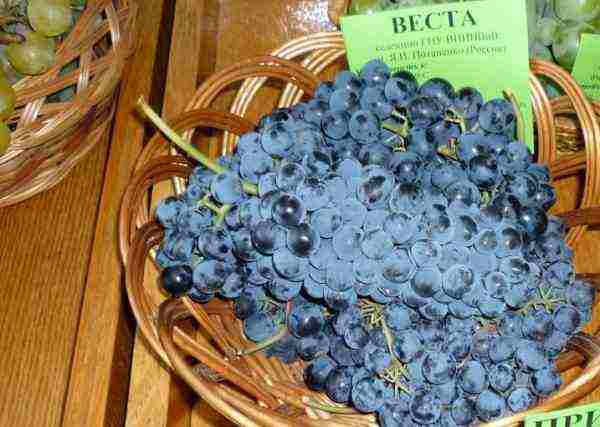
Dense clusters of the Vesta wine variety
Platovsky is a variety of wine and dessert grapes used to make table wines. A hybrid in central Russia and the Far East pleases with an amazing harvest already 115-135 days from the beginning of the growing season.The berries are white with a green tint, round, juicy, small clusters (200 g), very dense. Sugar content - 20%, acidity - 6 g / l. The vine is cut short enough (3-4 eyes), for the winter it is recommended to cover only in the zone of risky agriculture (Siberia, the Far East, the Urals).
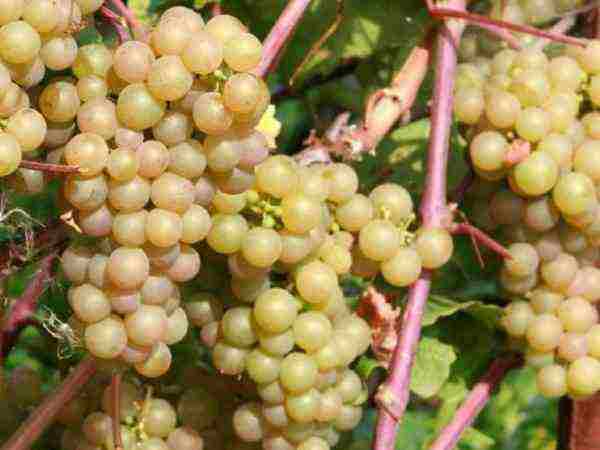
White-fruited technical grape variety Platovsky
Late ripening white-fruited variety The firstborn of Magarach forms clusters up to 200 g, is valued for its harmonious, pleasant taste, delicate skin. The berries are white, round, the brushes are elongated, loose. Sugar - 22%, acid - 8 g / l. The wine from Pervenets is light, with light nutmeg and fruity notes. An erect, powerful bush with an openwork crown is not covered for the winter and is often used as an arbor culture.
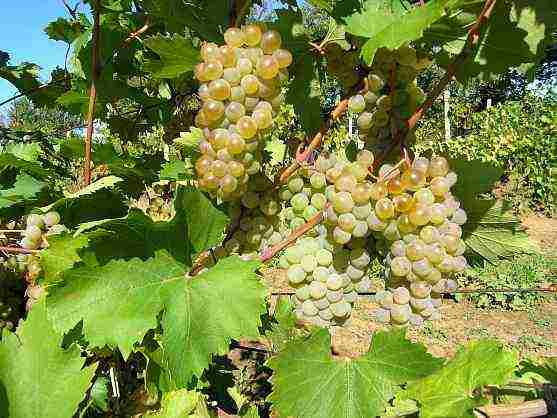
White-fruited technical grade Firstborn of Magaracha
Table: qualitative characteristics of some technical grape varieties
Photo gallery: varieties of technical grapes
The finest versatile table grape varieties
Lydia is the most common versatile variety, the juicy, sweet fruits of which with a spicy skin are loved by many gardeners. The vine is obtained from seedlings of the wild growing Vitis labrusca. Thanks to its powerful stem and decorative liana, the isabelle variety has spread not only as a table-technical grape, but also as an ornamental culture. Productivity - up to 25-30 kg per bush. An average bunch weighs about 400 g. Overripe berries crumble and rot, a ripe harvest (after 150–160 days) is ideal for juices and wines.
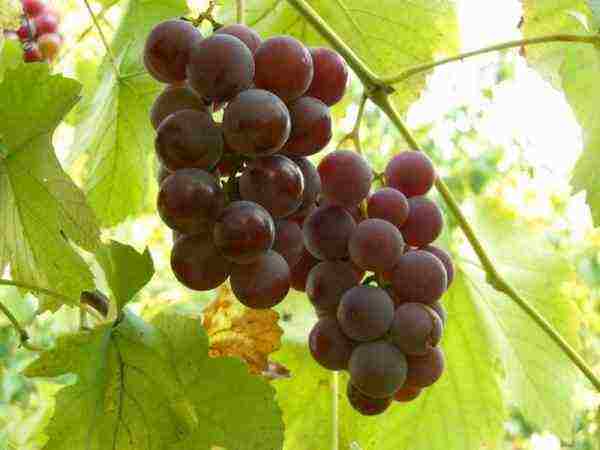
Universal variety Lydia
Hungarian white pearl universal grade suitable for processing and fresh consumption... Amber-yellow, round fruits with subtle nutmeg notes grow on conical clusters. The vine ripens by 80%. Fruit cluster weight - 150-200 g. Pruning - 6-8 buds. Sugar content - 20%, acidity - 7 g / l.A shrub with an average ripening period (120-140 days) is grown in Belarus and Ukraine, in the Urals and Siberia, as well as in central Russia.
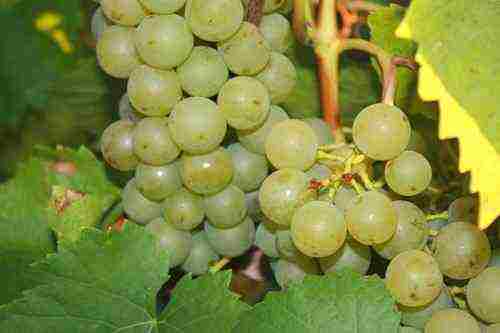
Universal White Pearl
Table-technical grade Black Pearl is a relative of Magarachi, clusters of about 300 g, berries are round, dark blue in color, with sourness and light strawberry nutmeg. Sugar content - 24%, acidity - 6 g / l. Cut grapes for 3-4 eyes, yield in favorable years - up to 15 kg from one bush. A frost-resistant variety of domestic selection was bred in Tula specifically for the production of high-quality dessert wines.
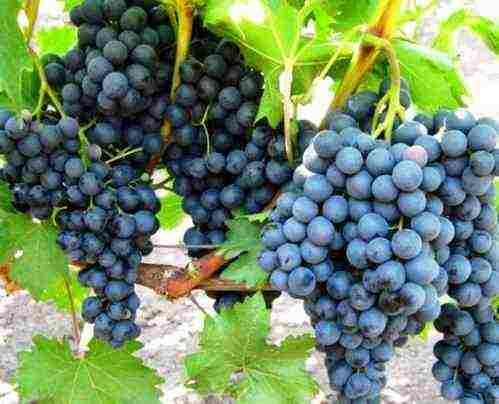
Variety for food and winemaking - Black Pearl
Pink Muscat is a medium-sized table-wine hybrid with bunches of up to 0.2 kg, oval, pink-red berries with a waxy coating. Fruits are fragrant, with floral notes, often used for winemaking, they will be an excellent berry dessert on the table. Average yield - 4-6 kg per bush. The variety is vulnerable to temperature extremes, is affected by powdery mildew and requires fertile soils and fertilizing.
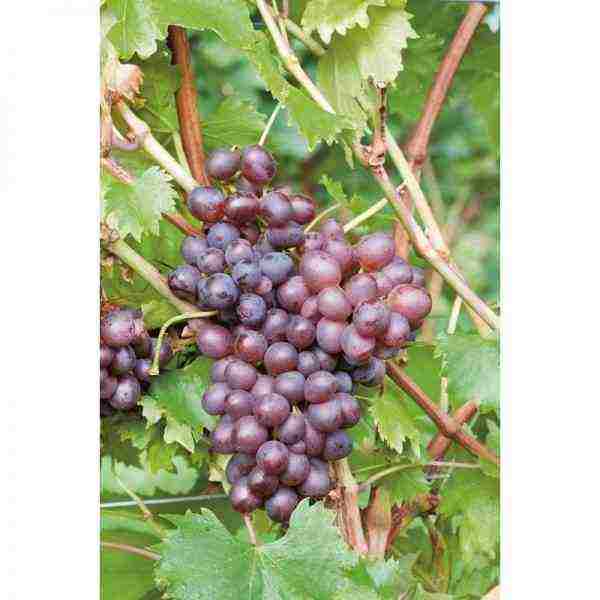
Grape variety Muscat pink
Chassela white, pink and nutmeg is a variety of grapes, which is often referred to as universal varieties. The hybrids are similar in their tasting characteristics, Chassela white (yellow-white, round berries, bunches weighing 190 g) ripens earlier than pink (pink-raspberry fruits with dense skin, brush weight - 250 g); Shasla nutmeg with yellow-green berries has a strawberry flavor, ripens much faster than all varieties of this subspecies. Grapes with sweet, juicy fruits look great on the table and are often highly prized for nutmeg and sugariness when tasting. All types of Chasselas grapes are suitable for wine. Frost-resistant and undemanding grape hybrids are suitable for the zone of risky farming - Moscow region, Petersburg, Bashkiria, Udmurtia, Siberia and the Far East.
Some of the best grape varieties in Russia
There are more than a thousand excellent early, middle and late grape varieties, the purpose of which is the most varied - some are good as a dessert, others for wine and preservation, some table and technical varieties are universal.
Video: the best grape varieties (with a short description)
The best grape varieties for the Moscow region and St. Petersburg
Unstable temperatures, rainy summers in the Moscow region and possible prolonged return frosts - these factors are always taken into account when choosing a grape variety. Therefore, more often in the garden plots near Moscow, early varieties grow - white-fruited Tason, Krasa Severa, Yubiley Novocherkassky, Rusven and the relatively early blue Athos.
In the damp temperate continental climate of St. Petersburg, a fruitful table hybrid in Memory of Dombkovskaya with dark blue fruits, early ripe Laura with large milk-green berries, Alyoshenkin, Harold, Libya, Druzhba are safely cultivated.
Resistant to diseases and low temperatures White maxi are distinguished by white-green large berries with sourness and fruity aroma. Of the technical varieties, gardeners near Moscow and St. Petersburg choose the uncompromising variety Lydia.
Video: the best grape varieties for the Moscow region and St. Petersburg
The best grape varieties for growing in Siberia and the Urals
Siberian gardeners practice the cultivation of frost-resistant early-ripening grape varieties - Tason, Timur, white-fruited Tukai; Rochefort, Super extra, White miracle, Cardinal and Codryanka with purple bunches, Delight, White giant are also popular. For winemaking, no doubt, Isobella and Lydia. The berries of Sharov's selection never fail: Sharova's Muscat and Sharov's Riddle.
Photo gallery: grape varieties for cultivation in Siberia
Video: the best grape varieties for the Urals and Siberia
The best grape varieties in Ukraine
The mild, southern climate and long, hot summers allow growing a variety of varieties of middle, early and late grapes for fresh use, making wine, juices, stewed fruit, candied fruits. Arcadia, Libya, Delight, Julian, Codryanka - ripen in mid-July. Maria Magdalene, Sphinx, Charlie with large dark purple bunches are popular ultra-early varieties; followed by hybrids with light green fruits - Bogatyanovsky, Aramis, Vanyusha, Lancelot, Lyubimy. In early August, the Odessa souvenir, Sigma, Romeo, Strashensky ripen. And at the end of summer, a rich harvest of dessert varieties Zagrava, Sentyabrina, Moldova is harvested; wine hybrids - Rodnichok, Isabella, Alpha.
Photo gallery: the best grape varieties for Ukraine
The best grape varieties in Bashkiria and Udmurtia
The famous hybrids of Sharov, Memory of Dombkovskaya and Korinka Russian are distinguished as the very first for the zone of risky agriculture in Bashkiria and Udmurtia. Super-early and medium-ripening varieties fully ripen and do not suffer from recurrent frosts: Super extra, Alladin, Saratov's Gift, Baikonur, Libya, Monarch. Not uncommon - Radiant Kishmish, Rumba and Early Violet. Working varieties are considered to be fruitful hybrids of Codryanka and Charlie.
Photo gallery: some of the best varieties of Bashkiria and Udmurtia
To prevent the berries from peeling and crumbling in the harsh Bashkir climate, it is imperative to treat the vine with various biostimulants (for example, Gibberellin)
Reviews
Working on new and better varieties, breeders take into account the demand for berry forms and their adaptation rates to different climatic conditions; and the development of winemaking forces amateur gardeners to work on the yield of technical and universal varieties. In any case, the most delicious and harvestable grape hybrids are those that are grown with their own hands on a personal garden plot. If you work tirelessly, even an ordinary universal grape variety will give you berries of amazing taste and aroma that will appeal to any gourmet.
Mena's name is Oksana. By education - an accountant, by vocation - an artist and a mother. I love to travel and appreciate in people sincerity and reliability. Rate the article:
(1 vote, average: 5 out of 5)
